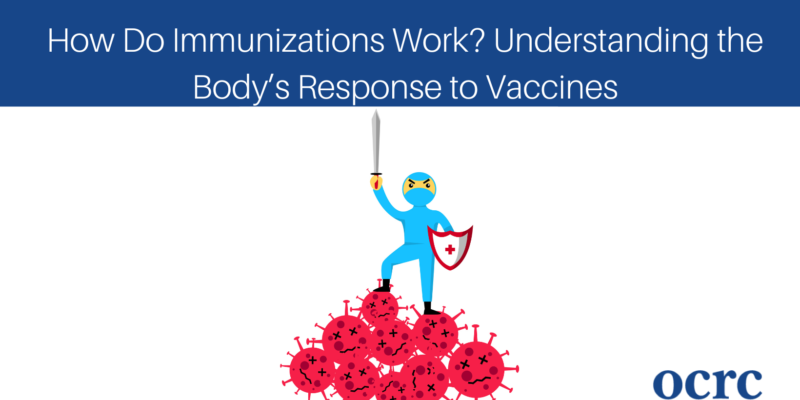
Vaccines help prevent the spread of deadly diseases and infections. The World Health Organization (WHO) states that immunization prevents four to five million deaths annually. While vaccine rates have declined in recent years, immunizations are still among the safest and most effective methods to avoid spreading deadly viruses.
So how do vaccines work in the body to stop the spread of disease? We will cover that and more in this article, but first, understanding vaccines requires knowing how the immune system functions.
When germs like bacteria and viruses enter the body, they begin to attack cells and multiply. The invasion of germs, known as an infection, can lead to the development of a disease.
When an infection occurs, the immune system will deploy white blood cells. These white blood cells work together to fight back and keep the individual healthy.
Macrophages are white blood cells that consume and digest invading cells and dead or damaged cells. When they destroy germs, they keep a piece of the invader, known as an antigen, and show it to the other immune cells.
White blood cells called T-lymphocytes and B-lymphocytes use the antigens to make pieces known as antibodies. Antibodies target invading cells carrying the matching antigen and destroy them.
After an infection, the T-lymphocytes recognize the germ if they see it again, and the B-lymphocytes quickly produce more antibodies to fight the new invaders.
Vaccines imitate an infection by supplying the body with antibodies, or proteins that protect the body from illness. Even though the vaccine is safe, the body mounts an attack as if the threat were real. This teaches the immune cells to quickly recognize the germs if they try to invade.
Sometimes, a vaccine can cause the body to develop minor symptoms as it builds immunity to a specific infection.
However, producing trained T- and B-lymphocytes can take a few weeks, so people can sometimes get infected just before or after getting a vaccine.
Fortunately, in cases where people do catch an infection post-vaccination, they are much less likely to experience severe symptoms than unvaccinated individuals.
In the United States, there are five main types of vaccines. These types include:
All five vaccine types are safe for most healthy people. However, those with a weakened immune system may not be able to have a live vaccine. Additionally, while an allergic reaction to a vaccine is rare, it is possible. For these reasons, herd immunity is critical to reducing the spread of infection.
Not everyone can receive every vaccine due to weakened immune systems, age, or allergies to specific vaccine components.
Nevertheless, those who cannot be vaccinated can still be protected from an infection when they live around a vaccinated population. In communities where most people are vaccinated, infections struggle to circulate due to the high immunity levels.
When the majority of a community is immune to an infection, it’s called herd immunity. While no vaccine can offer complete protection, when a significant proportion of the population immunizes, then a disease is more likely to be eradicated.
When most people are vaccinated, certain diseases become eradicated or eliminated worldwide. For example, in the 1970s, vaccination efforts successfully eradicated smallpox and eliminated polio in the US.
Since individual infections spread differently, the vaccination rate for certain diseases must be higher to offer herd immunity. For instance, if 95% of people are vaccinated against measles, mumps, and rubella (MMR), then measles becomes eliminated. However, if fewer than 90% of people are vaccinated for MMR, then MMR can begin spreading again.
Other infections require different vaccination rates to eliminate the disease, based on how easily it spreads. Polio’s vaccination rate needs to be 80% to achieve herd immunity.
Myths and misinformation about vaccines lead to vaccine hesitancy or those with access to vaccines refusing treatment. In 2019, the WHO listed vaccine hesitancy as one of the top ten threats to global health.
Clinical research and trials are critical to developing vaccines, understanding their efficacy, and protecting communities from public health crises. Those who qualify for clinical studies play an essential role in groundbreaking research.
Though we don’t currently have any vaccine studies available we do have openings available in others. Check out our current studies to see if you qualify to participate in one of our clinical studies.
